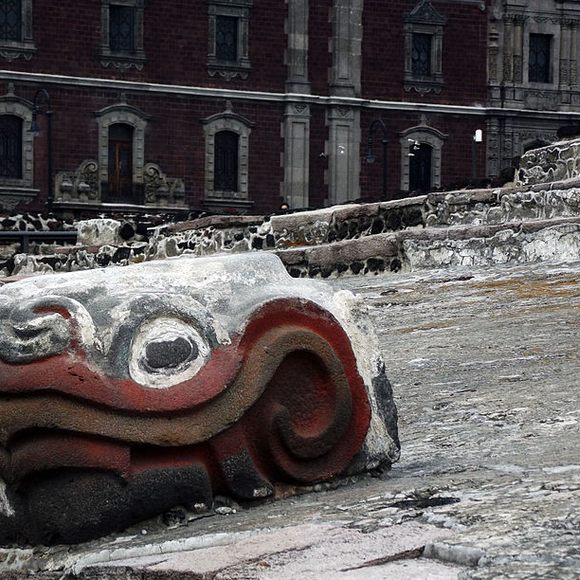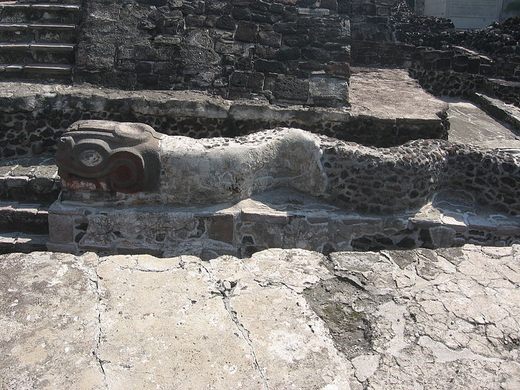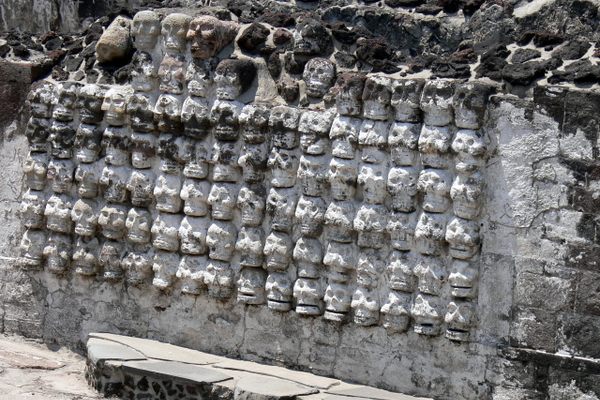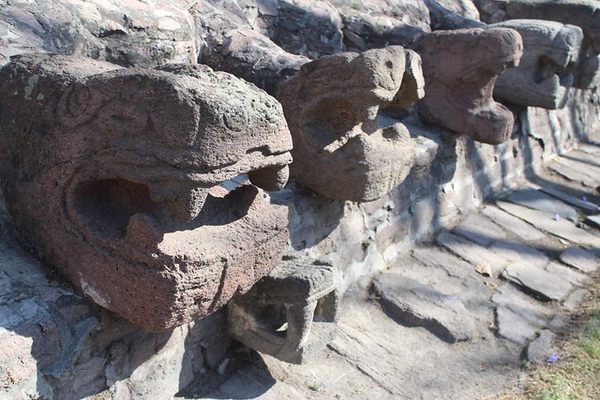Serpents of the Great Temple
These spectacular, symbolic serpents lie within the shadow of the Great Temple.
These menacing sculptures once sat at the foot of the stairs of a vast pyramid dedicated to Huītzilōpōchtli (Hummingbird’s South), the bellicose Aztec god of war with an insatiable appetite for blood.
The Aztec civilization practiced human sacrifice on an epic scale. Enemies captured in war raids and skirmishes were brought on a daily basis to the temple, painted blue with a mineral pigment, and then led past the stone serpents to climb the steps.
Once the unlucky prisoners had reached the summit, a knife-wielding high priest would tear their still-beating hearts from their chests. The priest would then hold the bloody, palpitating organ aloft as an offering to the sun and sky. The dead body was thrown down the steps of the temple.
The symbolic presence of these serpent sculptures at the foot of the temple signifies that the pyramid was originally meant to represent Coatepec (Serpent Mountain). In Aztec mythology, Coatepec was believed to be the mountain birthplace of the war god, Huitzilopochtli, whose mother Cōātlīcue (She of the Serpent Skirt) was a double-headed serpent goddess of the earth.
Cōātlīcue had given birth to the war god under the considerably traumatic circumstance of being beheaded by her four hundred children, led by a particularly jealous and matricidal daughter, Coyolxāuhqui (Painted with Bells). But at the moment her heads were cut off, Huītzilōpōchtli sprang from her womb, armed with weapons, and set about enthusiastically massacring his many siblings. He avenged the death of his mother by killing the murderer and cutting her into many pieces, which he then threw into the wind.
This myth was ritually reenacted by Aztec high priests who, seeking to appease the god and guarantee victory in war, would sacrifice the victim and hurl the corpse from the “serpent hill,” symbolically representing the death of Coyolxāuhqui. During the Spanish conquest of Mexico in 1521, the temple was the site of some of the fiercest battles between the conquistadors and the Aztec warriors and as a result was largely destroyed.
During the post-conquest period, the temple’s stones were paradoxically used to construct the cathedral to serve the new Catholic faith. The ruins were rediscovered in the 1930s by historians searching for the Great Temple. The site was subsequently excavated and reconstructed by archeologists.
The stone serpents were finally discovered and dug from the earth in 1948, receiving much media attention from both the National and International press. Today, the snakes have been restored to their former glory and placed out in the open just as they once were in ancient times, where they can be admired in all their ferocious beauty and historical significance.
Know Before You Go
If using public transport, take the train to the metro station Zocalo, which can be reached on the blue line (take direction Tasqueña). Upon leaving the station, walk to the right of the cathedral and cross the small plaza, where directly in front of you beyond the railings the temple ruins can be seen.
Although visiting the site itself and the museum is highly recommended, it is not necessary to pay an entrance fee to see the serpents, as they can be seen quite easily by looking over the metal railings surrounding the site. To see the sculptures up close, appreciate the rest of the ruins, and see the museum, it is necessary to pay a fee of 50 pesos (if you are a Mexican national you may enter for free). The ruins of the great temple are open from Tuesday to Sunday from 9:30 to 4:30 and at certain hours include a free guided tour in English or Spanish.




















Follow us on Twitter to get the latest on the world's hidden wonders.
Like us on Facebook to get the latest on the world's hidden wonders.
Follow us on Twitter Like us on Facebook